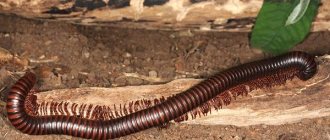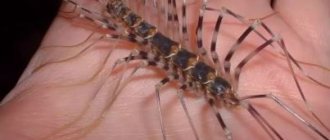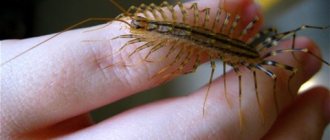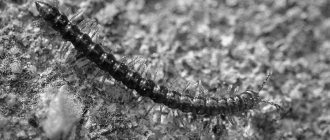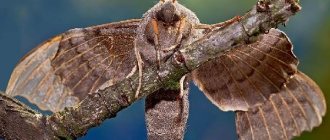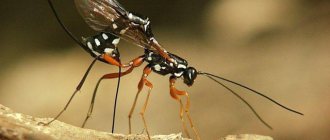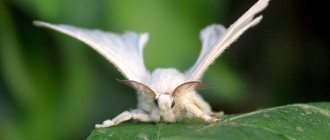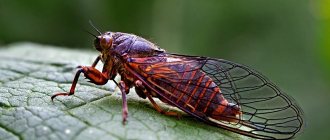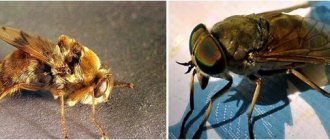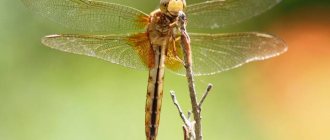The centipede insect is an amazing species, it looks terrifying, the length of an adult individual reaches 60 mm. The house centipede, or common flycatcher, feeds on insects and rids the house of various types of parasites. The centipede destroys and helps fight domestic insects such as: fleas; mole; cockroaches; silverfish; spiders and others who live with people and bring them various inconveniences and unpleasant sensations. In addition, the bites of many of them are painful, and for people prone to allergies, they bring additional health problems.
The centipede is not a pest; it destroys many harmful insects
But how do these arthropod creatures get into the house, where do they come from and why do they stay living next to humans? What attracts them here?
Appearance and body structure
Due to their characteristic appearance, centipedes have long been classified as insects. However, research has shown that these groups are not homogeneous, although they have a common ancestor.
The length of centipedes varies widely: from 2 mm to 40 centimeters. In regions with a warm climate, for example, in the Crimea, you can find quite large individuals, for example, Crimean hawks, whose body size reaches 4 cm. In areas with a cool climate, small representatives of the superclass are found.
The body of centipedes is segmented. The head consists of 4 or 5 segments. The body is not divided into sections and also consists of homogeneous segments.
The main feature of centipedes, which gave rise to their name, is the number of legs: individual representatives can have up to 750 of them. Interestingly, the number of pairs of legs is never even.
The color of centipedes can be black, reddish, or ocher. The younger the individual, the lighter the shade it has.
Is the bite dangerous for humans?
Having seen at least once how a flycatcher deals with its prey, anyone will wonder whether the centipede is dangerous for humans. This creature will not bite the skin of an adult, but a child may be harmed. But the poison is too weak to cause serious harm. Most often, the matter ends with redness and burning at the wound site.
flycatcher
Scolopendras are more dangerous; the content of toxins in their venom causes:
- burning pain;
- swelling at the wound site;
- temperature increase;
- nausea;
- decrease in blood pressure.
Symptoms disappear in 2–3 days. Complications can arise from individual intolerance to the poison.
Nutrition
All representatives of the superclass are predators. They usually eat:
- ants and their larvae;
- domestic cockroaches;
- flies, ticks.
Some species, such as the giant and ringed scolopendra, found in South America and Jamaica, are capable of hunting mice, frogs and lizards.
Centipedes use poison to paralyze and kill their victims. However, there is no need to be afraid of them: the poison produced by centipedes is harmful only to small arthropods, but not to mammals. In rare cases, the poison can provoke allergies.
Centipedes feed as follows. Having caught the victim, they inject poison into them and hold it with strong jaws and paws until the insect is completely immobilized. Only after this do they start eating.
Centipedes also destroy insects that harm agriculture. In some countries, for this reason they are under government protection.
Features of character and lifestyle
Photo: Black centipede
Centipedes are predominantly nocturnal, but can also be found during daylight hours in shaded areas. Flycatchers are true sprinters among all their relatives. If at rest this creature presses tightly to the surface, then while running it raises its body as much as possible.
Excellent eyesight and sense of smell, a special structure of the legs that allows them to stay on steep walls, made centipedes excellent hunters. Thanks to the flexibility of the body, they are able to penetrate even the narrowest crevices. For normal life functions, a lot of energy is needed, so they are almost constantly in search of food, tracking down unwary flies or spiders.
Sometimes centipedes are called centipedes, although these creatures have a lot of differences, and not only in appearance. Scolopendras, which live primarily in the tropics, are not as harmless as their centipede relatives. Their poisonous bite can cause significant harm to human health, including death.
Interesting fact: After touching centipedes, you must wash your hands and never touch your eyes, since there are poisonous glands on the sides of the body of these creatures, and the poison can cause severe irritation of the mucous membranes.
Reproduction
Centipedes lead a solitary lifestyle. In May and June they begin their breeding season. At this time, females begin to produce pheromones that attract males.
The fertilization process of centipedes is interesting. First, the male blocks the entrance to his home in the soil and deposits a sac with sperm - a spermatophore - into the resulting shelter. After this, the female crawls under the spermatophore, capturing it with her genital appendage. A few days later she lays eggs in the hole. The female creates a layer of sticky mucus on top of the eggs, which protects the offspring from predators.
One clutch can contain from 60 to 150 eggs. The female does not leave the clutch and drives other insects away from it. To prevent mold from appearing on the eggs, the centipede secretes a special substance whose composition resembles antifungal drugs.
Centipede larvae emerge simultaneously.
Difference in Behavior
Behavior is one of the easiest ways to determine whether a multi-legged critter found under a log or pile of leaf litter is a centipede or centipede. If it runs away immediately, it will be a centipede. If it curls up and remains motionless, it is a centipede.
This behavior hints at the common lifestyle of centipedes and millipedes. Most centipedes are fast predators that typically eat smaller arthropods. Millipedes feed on decaying plant matter. Instead of running away from predators, centipedes release irritating or poisonous chemicals to repel creatures that want to eat them.
Carrots, radishes and other foods that will help fight the runny nose
Only safe Internet: Wi-Fi will appear in all Russian schools by the end of the year
Presenter Ivan Urgant was offered to try himself as a political educator
How do centipedes get into apartments and houses?
A centipede living in the wild can accidentally enter a human home. However, there is a species that prefers to spend the winter in apartments and houses: the common flycatcher (below in the photo). It is called so because the basis of its diet are flies. In the warm season, it lives in fallen leaves. In winter, it is forced to seek refuge in a person’s home. Adult individuals of the species reach a length of 30-60 mm. Their body is gray-yellow, with blue or red stripes. The flycatcher's body is divided into 15 segments, each of which has a pair of legs. The first pair of legs is longer than the others: with their help, the flycatcher captures and holds prey.
The flycatcher is active both in the light and in the dark. She often sits on the walls of houses and barns, where she hunts cockroaches and crickets.
Flycatchers are not aggressive, but they can bite a person in defense. Their jaws are too weak to bite through human skin, but if they succeed (for example, a flycatcher bites a child), the sensation of its bite is reminiscent of a bee sting.
Flycatchers are considered useful because they are capable of destroying insects that cause much more harm to humans. However, due to their frightening appearance, people who notice flycatchers in their home prefer to get rid of them.
Where does the centipede live?
Photo: Centipede in Russia
Centipedes are found in abundance in countries and regions with temperate, hot climates.
Its natural habitat is:
- the entire Middle East, northern Africa, central and southern Europe;
- southern regions, central Russia, Volga region;
- Ukraine, the entire Caucasus, Kazakhstan and Moldova;
- Mediterranean countries, India.
For reproduction and normal life, centipedes need moisture. In forests it is easy to find under almost any stone, at the roots of trees, among fallen leaves. With the onset of autumn, these creatures look for warmer, secluded places and quite often appear in human dwellings. They most often do not live permanently in apartments and houses, but only wait out the cold. In winter they hibernate, but with the first warmth they come to life and move to their natural habitat.
In human dwellings, flycatchers can be found:
- in basements and cellars;
- bathrooms;
- any rooms with high humidity.
Interesting fact: Penetrating into a living space through cracks in the walls or through a pipeline, centipedes live only in one specific place and do not move. They do not multiply to incredible numbers like cockroaches, and do not spoil food, furniture, flowers, and so on.
Sometimes flycatchers appear indoors even in summer. They can be attracted by various insects that live in abundance in human housing due to unsatisfactory sanitary conditions.
Getting rid of centipedes
To get rid of centipedes, you should create the most uncomfortable living conditions for them:
- reduce indoor humidity (centipedes cannot reproduce if it is not humid enough);
- the bathroom must be regularly ventilated;
- it is important to get rid of mold;
- regularly clean baths and other damp areas using soda and products containing chlorine;
- cracks in windows and doorways must be eliminated using sealant or construction silicone;
- it is necessary to get rid of insects (crickets, cockroaches), since they form the basis of the diet of centipedes;
- If there are not very many centipedes, it is enough to catch them by hand. In this case, you must follow safety precautions by wearing thick gloves.
These methods will be ineffective if the centipedes have managed to breed in large numbers. In this case, you will have to resort to the following methods:
- boric acid: powder or solution must be applied around the perimeter of the room;
- diatomaceous earth powder: this product is safe for humans and pets, but it repels centipedes; should be scattered around the perimeter of the room;
- insecticides for controlling insects (Clean House, Raid, etc.).
Keep in mind that sticky tapes against centipedes are not effective. Only the individual’s paws will remain on the tape, which will regenerate after some time.
Natural enemies of centipedes
Photo: What a centipede looks like
Centipedes have a small number of enemies, since due to the large number of poisonous glands, they are not to the taste of many predators, and for some they can also be dangerous. However, centipedes do not mind snacking on snakes, rats and even cats. For rats and pets, snacking on these creatures risks becoming infected with parasites that can inhabit the bodies of poisonous “caterpillars.”
It has been noticed that some species of centipedes, for example scolopendra, in an artificial habitat can eat their own relatives, especially young animals. In nature, this happens extremely rarely and only when there is not enough usual food. Most often, these creatures coexist peacefully without getting into fights. Only sometimes males can cling together with their many legs and lie curled up in a ball for 10-15 minutes, and then disengage and go about their business again.
Interesting fact: The largest representative of the centipede superclass reaches a length of 35 centimeters. This is a poisonous giant scolopendra that is found only in the tropics and its bite is often fatal to humans.
If a young, inexperienced bird accidentally grabs a centipede from the ground for a snack, it immediately spits it out. More experienced individuals do not touch centipedes at all.
Harm and benefit
Centipedes cause virtually no harm. Some species, in the absence of suitable food (insects), can damage the roots of seedlings in greenhouses. However, they prefer weeds.
Centipedes bring tangible benefits to agriculture. They prey on insects (caterpillars, ticks, flies, mosquitoes), significantly reducing their numbers. They are also considered soil formers: by making passages in the soil, they improve its ventilation.
Interestingly, the poison of some species is used in folk medicine. For example, Chinese red scolopendra is used in the east to treat skin diseases. Its venom is believed to speed up the healing process.
Some people even keep and breed centipedes at home, placing them in a special terrarium.
Habitat
Centipedes and centipedes are found on every continent except Antarctica. They live exclusively on land, although at least one species of giant centipede can swim.
Centipedes are found in all types of terrestrial habitats, even in caves deep underground, but they are especially common in extremely dry conditions. Deserts are home to some of the largest centipedes.
Millipedes, in turn, prefer moist soil and leaf litter in forests, although some species are found in grasslands or deserts. Unlike their relatives, centipedes lack a waxy layer on their exoskeleton to help retain water.
Down with terry: why you need to include paper towels in your skin care
Strength or Prosperity: Choose one card and find out what the butterflies say about the future
To eliminate “gray” SIM cards, Roskomnadzor wants to arrange total surveillance
Encounter with Scolopendra
Giant centipedes, distinguished by their aggressive nature and toxic poison, are found in the tropics and subtropics. Residents of the temperate zone should not fear a collision with a 30-centimeter giant, capable of easily killing a small snake. In Europe, there are individuals that are half the size of representatives of tropical species. Why is scolopendra dangerous for humans? The bite of a poisonous centipede is very painful. In most cases, the dose of injected poison is small; it will not kill or paralyze an adult. Children are at greater risk; their bodies have still formed a strong protective immune system. An attack by a large animal on a child can lead to serious consequences.
On the territory of Russia, scolopendras are found only in several regions - Crimea, the Caucasus, Rostov region and Krasnodar region. Small centipedes, 12-14 cm, live here. This is the ringed centipede. She is nocturnal and at dusk goes out to hunt for insects and small lizards. The species is not aggressive, but you should be careful during overnight hikes. A centipede can crawl into a tent or sleeping bag
You should also be careful when collecting branches for the fire. Accidentally disturbing a centipede will get a bite comparable to the sting of 20 bees
The effect of the poison is not fatal, but extremely unpleasant and painful. Claws on numerous limbs leave red spots on the skin if the arthropod simply runs across the body.
Insect species
There are several dozen species of centipedes, the main similarities of which are their general structural features and a large number of limbs. The giant scolopendra lives in South America. Due to its large size, small rodents, amphibians and birds can become its victims. The jaws of this scolopendra are poisonous; the insect’s bite can cause harm to humans (weakness, swelling and pain).
Scutigera typically has a yellow-gray body color and long, striped limbs. Its length is about 6 centimeters, it feeds on arthropods and lives in Africa, Kazakhstan, the Caucasus, and in the southern part of Russia - in countries with a warm climate. She often lives in fallen leaves, but with the onset of cold weather she looks for a warm shelter.
In winter, Scolopendra scutigera may end up in a person’s home. It is not able to bite through the skin, but its bite can be compared to that of an aspen. Also, scutigera does not harm furniture or spoil food supplies, so in some areas it is considered a useful centipede that eats pests. In the photo below you can see what this type of animal looks like.
Ringed species live in southern European countries and are about 15 centimeters long. This is a dexterous predator that eats arthropods and small reptiles.
Ways to control house centipedes
If you absolutely do not want little hunters living in your neighborhood, there are many methods that will help get rid of them. The best way is to create unfavorable conditions for the existence of centipedes. First of all, tidy up the rooms where dampness may be present; if there is no familiar environment, the flycatchers will look for another habitat.
Since centipedes feed on a variety of insects, try to ensure that they leave your home. Centipedes cannot stay indoors for long without food.
It is necessary to replace old pipes in the bathroom that may be leaking, and repair all the plumbing. If your apartment has a wooden floor, you need to carefully inspect it for the presence of cracks and holes, and if you find their presence, carefully seal them. Varnishing the floors will also help solve the problem, because flycatchers do not like chemical smells.
get rid of house centipedes in the following ways:
- It's good to clean around your home. It is necessary to sweep up fallen leaves where flycatchers can hide, and clear the yard of unnecessary building material that has been lying around for a long time. Centipedes will lose their usual place of residence and will leave your territory.
- Usually 2-3 flytraps can live in an apartment, so you can catch them with a box or jar and release them outside. Just don’t kill the little hunters, even if they look unattractive, they haven’t done anything bad to you.
- To get centipedes away, deprive them of their food source by getting rid of small insects living in the house.
- Since centipedes love only a moist environment, thoroughly clean basements, storage rooms, and toilets so that they are dry, clean and light, which arthropods really don’t like.
- Carefully seal all cracks and cracks in floors, baseboards, and along doors and windows to prevent centipedes from entering your home. You also need to use a dense mesh to close the ventilation windows well.
- If all these methods do not help, use chemicals, but only in the most exceptional cases. To do this, it is necessary to treat all habitats of centipedes with poisonous preparations to kill insects.
to get rid of flycatchers in your garden or vegetable garden , since the little hunters will never cause harm to your crops, and will even help you by ridding your garden plot of various pests.
